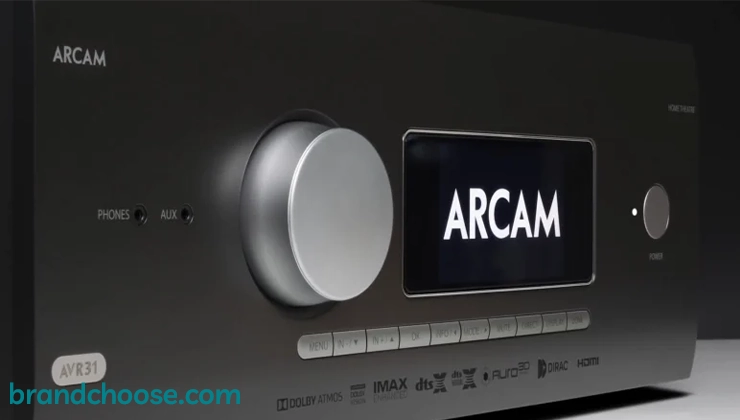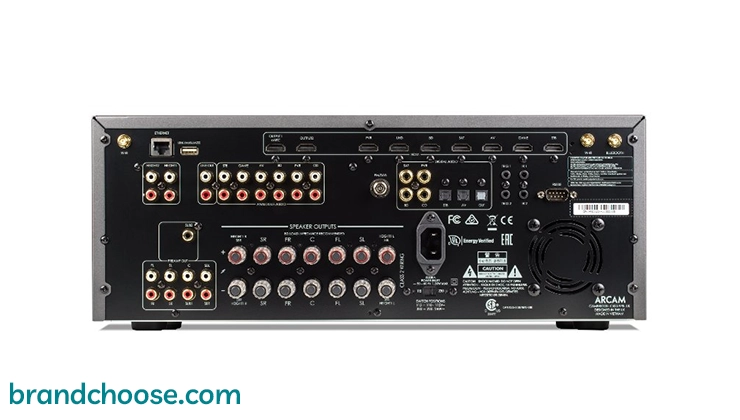Marantz AV Receivers
In the realm of home entertainment, the quest for superior audio experiences drives enthusiasts to explore the world of audio-visual (AV) receivers. Among the myriad of options available, Marantz AV receivers stand out as symbols of innovation, performance, and sophistication. In this article, we embark on a journey to unravel the essence of Marantz AV receivers, uncovering their unique features, advantages, disadvantages, and why they deserve a prominent place in your home theater setup.
What are Marantz AV Receivers?
Marantz AV receivers epitomize the pinnacle of audio excellence, serving as the cornerstone of your home entertainment system. Meticulously crafted with precision engineering and a dedication to sonic purity, Marantz receivers decode, amplify, and distribute audio signals with unmatched clarity and fidelity. Infused with cutting-edge technology and a legacy of audio innovation, Marantz receivers deliver an immersive listening experience that transcends expectations.
Why are Marantz AV Receivers superior?
Marantz AV receivers boast several features that distinguish them from the competition:
Power Output
Marantz, a reputable name in the AV receivers segment, is highly regarded for its power output capabilities. Their latest models, such as the SR8015, boast a robust power output of 140 Watts per channel at 8 Ohms, delivering dynamic and impactful audio. This high power output ensures even distribution of sound, maintaining consistent quality even in larger rooms or open spaces. Marantz AV receivers also incorporate advanced technologies like Hyper Dynamic Amplifier Module (HDAM) circuitry, offering a wide dynamic range, lower distortion, and excellent signal-to-noise ratio. However, while Marantz excels in power output, it's essential to note that this might result in higher energy consumption, which could be a downside for some users. In comparison to other brands, Marantz often stands out for its superior sound quality, largely attributable to its high power output. Brands like Denon, Yamaha, or Sony offer models with similar power output, but Marantz frequently leads in overall sound quality and consistency. However, these other brands might offer more energy-efficient alternatives, which could sway certain consumers.

Sound Quality
Marantz, a well-established player in the AV receivers domain, is celebrated for its exceptional sound reproduction. Leveraging advanced technologies like High Definition Compatible Digital (HDCD) and Direct Stream Digital (DSD), the brand ensures the delivery of high-resolution audio. Marantz AV receivers also feature Hyper Dynamic Amplifier Modules (HDAMs), providing outstanding low noise wideband performance for an optimal soundstage. These technologies combine to deliver a crisp, detailed, and immersive auditory experience. However, while Marantz AV receivers generally receive acclaim for sound quality, some users have noted a slightly warmer and softer sound compared to other brands. This is more a matter of personal preference than a drawback. In contrast to brands like Denon or Yamaha, Marantz tends to prioritize musicality and warmth, which may not appeal to those preferring a more analytical or bright sound. Nonetheless, Marantz's dedication to sound quality remains undisputed, positioning it as a strong contender in the AV receivers market.
Number of Channels
Marantz, a renowned name in the AV receivers segment, offers a wide array of models with different channel configurations. Their latest releases, like the SR7015, deliver up to 9.2 channels, promising an immersive home theater experience. This includes support for cutting-edge surround sound technologies such as Dolby Atmos, DTS:X, and Auro-3D. The advantage of having more channels lies in the ability to create a detailed and lifelike soundstage, enhancing the overall audio immersion. However, it's essential to consider that while more channels can enhance sound quality, it also necessitates more speakers, which might pose challenges in terms of cost and space. When compared to other brands in the AV receivers segment, Marantz distinguishes itself for its top-notch audio reproduction, even in models with fewer channels. Brands like Denon and Yamaha offer similar channel counts, but Marantz often earns praise for its superior audio quality and richness across all channels.
Arcam AV Receivers
In the realm of home entertainment, the heart of a truly immersive experience lies within the audio-visual (AV) receiver. Among the myriad of options available, Arcam AV receivers stand out as beacons of innovation, performance, and reliability. In this article, we delve into the realm of Arcam AV receivers, uncovering what makes them exceptional, their unique features, advantages, disadvantages, and why they deserve a place in your home theater setup.

Feauturs you need to know about Arcam AV Receivers
Sound quality
Arcam, a renowned brand in the AV receivers category, is globally recognized for its exceptional sound quality. The brand utilizes the latest technologies such as Class G amplification, which ensures optimal sound performance by reducing distortion and enhancing audio clarity. Arcam's AV receivers, such as the AVR20 and AVR30, are equipped with the state-of-the-art ESS Sabre DACs (Digital-to-Analog Converters), which significantly contribute to the high-resolution audio output, providing a rich, detailed, and immersive sound experience. However, while the sound quality of Arcam's AV receivers is commendable, it's worth noting that they are generally more expensive than other brands offering similar features. This could be a potential drawback for budget-conscious consumers. Compared to other brands like Denon or Yamaha, Arcam stands out for its emphasis on sound performance over extensive features. While brands like Denon might offer a wider array of connectivity options or Yamaha might focus on versatility with music streaming services, Arcam's primary focus remains on delivering superior sound quality. Therefore, for audiophiles who prioritize sound quality above all, Arcam's AV receivers could be an excellent choice.
Number of channels
Arcam, a renowned name in the AV receivers category, offers a range of products with varying numbers of channels, catering to different user needs. Their latest models, such as the AVR30 and AVR20, offer 7.1.4 and 7.1.2 channels respectively. These models are equipped with the latest technologies including Dolby Atmos, DTS:X, and IMAX Enhanced, providing a rich and immersive audio experience. One of the key advantages of Arcam AV receivers is their ability to deliver high-quality sound across all channels, making them an excellent choice for home theaters. However, compared to some other brands, Arcam receivers might be limited in terms of the number of channels they offer. Brands like Denon or Marantz, for instance, offer AV receivers with up to 11 or 13 channels. This could be a potential drawback for users looking to set up more complex home theater systems. Nonetheless, Arcam's focus on sound quality over quantity sets them apart, and they continue to be a strong contender in the AV receiver market.
Power output
Arcam, a renowned brand in the AV receivers category, is well recognized for its power output. The brand's latest models, such as the AVR390, AVR550, and AVR850, are equipped with the latest technologies that ensure a high power output. The AVR850, for instance, boasts a class G amplification, delivering over 120 watts per channel, which is quite impressive. This high power output ensures that the audio is loud, clear, and distortion-free even at high volumes, providing an immersive audio experience for users. However, it's worth noting that while Arcam's power output is commendable, it may not always be the most energy-efficient, especially when compared to brands like Denon or Yamaha. These brands have incorporated Eco mode in their AV receivers, which helps in reducing power consumption. Despite this, Arcam's power output quality is still highly competitive. The brand's focus on delivering high power output without compromising on the audio quality sets it apart from many other brands in the AV receivers category.

Connectivity options
Arcam, a renowned brand in the AV receivers category, offers a variety of connectivity options in their models that cater to the needs of modern users. One of the key features is the inclusion of HDMI 2.1 ports, which support 8K/60Hz and 4K/120Hz video pass-through, ensuring compatibility with the latest high-definition video formats. Additionally, Arcam AV receivers also provide eARC (Enhanced Audio Return Channel) support, which allows for the transmission of Dolby Atmos and DTS:X from TV apps with a single HDMI connection. In comparison to other brands, Arcam stands out with its inclusion of Dirac Live room correction technology, which can be connected to a computer for a higher level of customization. However, one potential downside is that some users may find the lack of built-in Wi-Fi a drawback, as many competitive models offer this feature. Nevertheless, Arcam compensates with Ethernet connectivity and Bluetooth, ensuring users can still stream music from devices or connect to home networks. Despite these minor cons, when it comes to connectivity options, Arcam AV receivers are on par, if not superior, to many other brands in the market.















